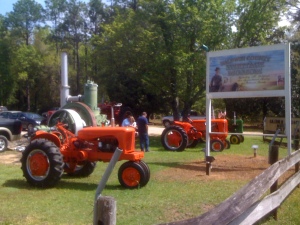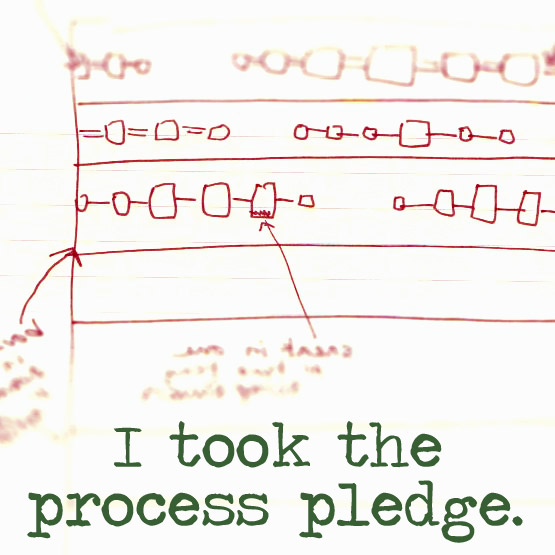Today I joined my DH for a trip to the Baldwin County Historical Museum in Elberta, Alabama. There was a German Sausage Festival going on in Elberta, a town settled by a large number of Germans many years ago. The Sausage Festival occurs twice a year, Spring and Fall. It is so popular that you have to go early and get your sausage early as they run out most years. We went to the festival last year. This year, the Southern Alabama Antique Tractor and Small Engines Club was asked to go to the Historical Museum to draw attention to the Museum on the day of the Sausage Festival.
The Museum is about 1/2 mile from the location of the Sausage Festival and is a gem hidden back in the trees. Like the pearl found in the ugly shell of Coast oyster, the museum is hidden from plain view by its plain building. Parking six or eight antique tractors, all colorfully restored to their original colors, draws the needed attention to the Museum.
In the foreground is our 1950 Allis-Chalmers WD tractor restored to its original state and color, AC Orange.
I don’t usually accompany DH to his tractor events but last year he had been there and took a few quilt photos that had me anxiously waiting for the day I’d go see them in person. I was NOT disappointed. There were many quilts and many sewing machines plus lots of other good things to see. The day went by quickly and I was indoors in air conditioning for most of this sultry southern day.
I know you want me to share with you some of the things I saw. There were some firsts for me in this museum and maybe for you. Let’s begin.
When we arrived, one room was full of musicians. They played steadily from 10 a.m. to noon; dulcimers, mandolins, guitars, fiddles, recorders, an occasional harmonica and I probably left out some things. Here’s one Southern gentleman still hanging on to his Confederate roots.
I enjoyed the music, folk and gospel mostly but I was waiting for them to vacate the room so I could examine the four quilts hanging on the wall behind them.
One of the four on the wall, all done by the Elberta Arts and Crafts Club around 1950, they were all expertly appliqued and hand-quilted. That’s the state of Alabama in the center. Elberta is located way down in the lower right hand corner where you see some lines.(near the whale)
Second of the four, this one shows various livelihoods practiced in the early days of Elberta’s history. Oystering, logging, farming, pecan trees, fishing, shrimping all are depicted here.
Third on the wall, this shows some of the farmsteads and crops that yielded a healthy crop and a good income for the early settlers of Elberta, AL.
These quilts were worth waiting for!! They were so well done. I love the view from above the countryside (center of the quilt above).
To go with these four lovely applique quilts, I moved into another room to enjoy the antique sewing machines and other items. Come with me to see some of them.
This basket quilt, done all in brown/tan/white baskets on a royal blue background is lovely. This is a very typical 1800’s quilt block. I think the use of the browns/tans and whites is a bit unusual. Most I’ve seen have been done in pastels. I love the hand quilting pattern.
The card accompanying this quilt states it was made by an Emma Holland in the 1880’s and was gifted and handed down three times before it was sold by the fourth owner to get money to move her mother to Texas.
Do you suppose it might have been pieced on this treadle machine?
Or this one?
This is a very rare sewing machine. It was the first that allowed fabric to be fed under the needle and used a straight needle. It was developed and patented by a Mr. Wilson. Mr. Wilson later was joined by Mr. Elias Howe and Mr. Singer. They eventually joined together in a Sewing Machine Combination and were able to use each other’s patents to continue the progress in development of the sewing machine.
I have seen this pattern before but can’t think of what it’s called. Well done, don’t you think?
This seems like a rather small washtub for washing a full size quilt, am I right?
A utilitarian crazy quilt, tied rather than quilted. All types of fabric could be used in these crazy quilts. Wools and linsey-woolsey, cottons, feed sacks all were used. Satins and velvets were used for more special quilts.
Quilting wasn’t the only needlework done by the 1900’s woman. Here are some things to remind us of how “the more things change, the more they stay the same”.
Wooden clothespins with this lovely hand embroidered clothespins bag.
Hankies with tatted edging.
Basket of star blocks….and we’re still fascinated with star blocks!
Button, button, who’s got the button? Bone buttons. They don’t make them like they used to!
Sewing basket, drop spindles, more
Early apron pattern
Feedsack fabrics – for quilts, dresses, and aprons
A version of a “Grandmother’s Fan” block?
Weaving looms
Do you enjoy your Rowenta iron? Have a favorite iron because it heats up fast, gives great steam and is lightweight to handle? Consider yourself very fortunate. Check out these early irons.
Charcoal Iron – Hot charcoal was put into the interior of the iron to heat it for use. That’s sounds like a burn waiting to happen! And yet, it gets worse!
Kerosene Iron That little canister of kerosene……yikes!
I remember my grandmother having a cast iron that sat on the back of her wood stove staying hot for whenever she decided she wanted to iron her aprons. She always had three or four of the hot irons sitting on the back of the stove. I remember her always wearing a crisp, freshly ironed apron. I learned to iron clothes at her ironing board (that dropped down out of the wall in the kitchen). You picked up the iron with a wooden handle. You squeezed this one place and it allowed you to grab the hot iron and get to work. They had photos of some of them and I didn’t think to take a photo of them too.
A collection of needle cases.
Rugs crocheted with old feed sack fabric; and we think we invented recycling/upcyling. Not!
Wondering what to wear for Easter? Maybe this pattern would be helpful. 😉
A few final quilt shots…..
circa 1900 Redwork quilt (Notice the cows-farm motifs).
John Deere farm tractor applique – steel wheels
Quilt block…name unknown to me. Check out the fabric choices. No trip to the fabric store to get coordinating fabrics!
Another block I don’t recognize.
I sure hope you enjoyed this visit to the Baldwin County Historical Museum. It’s open Wednesdays through Saturdays, 9-3 , Rt. 98, Elberta, Alabama. If you’re in the area, be sure to stop by for a step back in time.
For the husbands, there’s old tractors, old machines, old tools, a whole room devoted to the shipwreck “Republic” and it’s treasures found when the ship was dredged up. There’s also this lovely swinging seat on the front porch where you can benefit from a cool breeze and admire the garden.
I’ll be back….and I promise to share the photos of the Pensacola Quilt Show. I will, I promise. I also want to share with you my latest project so stay tuned and come back soon!
Always in stitching,
Marsha














































